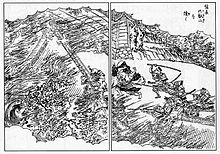Siege of Mount Hiei
| Siege of Mount Hiei | |||||||
|---|---|---|---|---|---|---|---|
| Part of the Sengoku period | |||||||
 Nobunaga forces setting fire to Enryaku-ji and massacring the monks (depiction in the Ehon taikōki) | |||||||
| |||||||
| Belligerents | |||||||
| Forces of Oda Nobunaga | Sōhei of Mt. Hiei | ||||||
| Commanders and leaders | |||||||
|
Oda Nobunaga Akechi Mitsuhide | Various monk leaders | ||||||
| Strength | |||||||
| 30,000 | Unknown | ||||||
| Casualties and losses | |||||||
| Unknown | 20,000 or more[1] | ||||||
The Siege of Mount Hiei (比叡山の戦い, Hiei-zan no Tatakai) was a battle of the Sengoku period of Japan fought between Oda Nobunaga and the sōhei (warrior monks) of the monasteries of Mount Hiei near Kyoto on 29 September 1571. Nobunaga and Akechi Mitsuhide led 30,000 men to Mount Hiei, destroying towns and temples on the mountain or near its base, and killing their residents without exemption.[2] Nobunaga killed an estimated 20,000 people and around 300 buildings were burned to the ground, ending the great power of the Mount Hiei warrior monks.
Background
The Tendai monks of Mount Hiei, a strategic mountain to the northeast of the capital Kyoto, were long great enemies of Oda Nobunaga and had formed an alliance with his rivals, the Azai and Asakura clans. Nobunaga viewed the warrior monks as a major threat due to their strength and independence, as well as their highly-strategic position near Kyoto. Nobunaga decided to eliminate the monks with a pre-emptive scorched earth attack on Mount Hiei and nearby settlements.
Siege
On 29 September 1571, Nobunaga's men under Akechi Mitsuhide attacked the town of Sakamoto (located in present-day Ōtsu) at the base of Mount Hiei before moving up the mountain towards the Tendai temples. Nobunaga then destroyed the Hiyoshi shrine honoring Sannō, the kami of the mountain. Nobunaga's massive force encircled the mountain and gradually moved upwards, killing and destroying anyone or anything in their way. Eventually, they made their way to Enryaku-ji, the powerful and famous temple at the summit, which was razed to the ground. Nobunaga's arquebusiers then formed search parties and eliminated anyone who had previously escaped their attack.[3]
Aftermath
Only one minor building survived the siege, the Ruri-dō (るり堂, "Lapis Lazuli Hall"), which is located down a long, unmarked path from the Sai-tō complex.[4] The structure dates originally to the 13th century and was repaired twice in the 20th century. Reconstruction of Enryaku-ji commenced not long after the death of Oda Nobunaga and his successor Toyotomi Hideyoshi, but never regained its former size. Nobunaga's merciless attack on Mount Hiei earned him renown in Japan and led to some branding him the "Devil King" or "Devil Daimyō".
Historical context
George Sansom states, "That the whole mountainside was a great slaughterhouse, and the sight was one of unbearable horror."[5]
According to Stephen Turnbull, so one-sided was the siege that it should more rightfully be called a massacre than a siege or battle.
References
- ^ Turnbull, Stephen (2003). Japanese Warrior Monks AD 949-1603. Oxford: Osprey Publishing. p. 20.
- ^ Totman, Conrad (1995). Early modern Japan (1. pbk. print. ed.). Berkeley: University of California Press. p. 43. ISBN 978-0-520-20356-3.
- ^ Turnbull, Stephen (2000). The Samurai Sourcebook. London: Cassell & C0. p. 221. ISBN 1854095234.
- ^ http://www.kagemarukun.fromc.jp/page005e.html
- ^ Sansom, George (1961). A History of Japan 1334–1615. Stanford: Stanford University Press. p. 284. ISBN 0804705259.
Further reading
- Turnbull, Stephen (2003). Japanese Warrior Monks AD 949–1603. Oxford: Osprey Publishing.
- Turnbull, Stephen (2005). Japanese Fortified Temples and Monasteries AD 710–1602. Oxford: Osprey Publishing.
